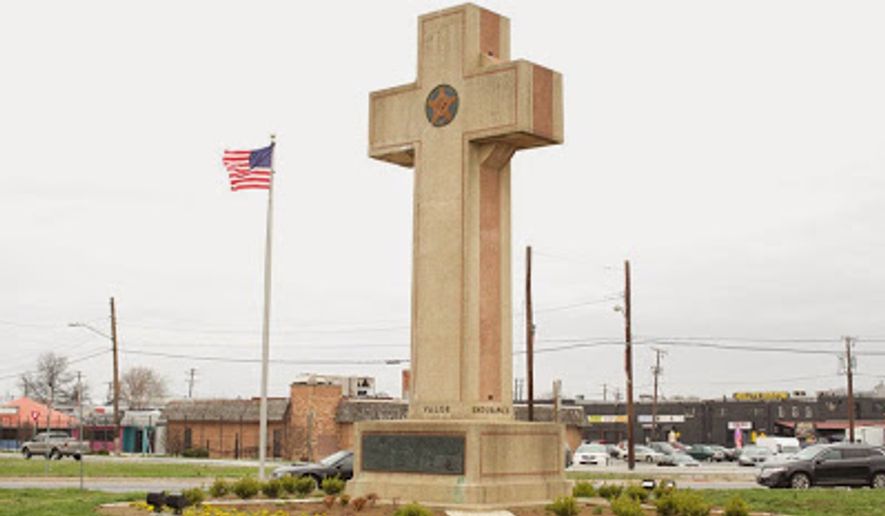A three-judge court panel ruled Wednesday that a World War I memorial in the shape of a cross in Bladensburg, Maryland, is unconstitutional, a decision that a legal scholar says could imperil other similar memorials.
In a 2-1 decision, the U.S. Court of Appeals for the 4th Circuit said the 40-foot cross erected 92 years ago violates the First Amendment’s Establishment Clause.
“The monument here has the primary effect of endorsing religion and excessively entangles the government in religion,” Judge Stephanie Thacker wrote for the majority. “The Latin cross is the core symbol of Christianity. And here, it is 40 feet tall; prominently displayed in the center of one of the busiest intersections in Prince George’s County, Maryland; and maintained with thousands of dollars in government funds.”
The Bladensburg World War I Veterans Memorial is dedicated to 49 servicemen who perished in WWI. The cross is owned and maintained by the Maryland-National Capital Park and Planning Commission, which acquired it from the American Legion in 1961 due to development around the cross.
In 2014, the American Humanist Association filed a lawsuit asking for the cross to be demolished or altered, such as by removing its arms “to form a non-religious slab or obelisk.”
“Government war memorials should respect all veterans, not just those from one religious group,” Roy Speckhardt, the association’s executive director, said in a statement Wednesday. “Religious neutrality is important in a pluralistic society like ours.”
The First Liberty Institute, a pro-religious freedom group, intervened on behalf of the American Legion.
“Today’s decision sets dangerous precedent by completely ignoring history, and it threatens removal and destruction of veterans memorials across America,” Hiram Sasser, deputy chief counsel for First Liberty, said in a statement.
In his dissenting opinion, Chief Judge Roger L. Gregory said the First Amendment “does not require the government ’to purge from the public sphere’ any reference to religion.”
“This Memorial stands in witness to the VALOR, ENDURANCE, COURAGE, and DEVOTION of the forty-nine residents of Prince George’s County, Maryland ’who lost their lives in the Great War for the liberty of the world,’” Chief Judge Gregory wrote. “I cannot agree that a monument so conceived and dedicated and that bears such witness violates the letter or spirit of the very Constitution these heroes died to defend.”
The court rejected the argument that removing the cross would set a precedent for removing other war memorials with religious references, such as the crosses that line Arlington National Cemetery.
“The crosses there are much smaller than the 40-foot tall monolith at issue here,” Judge Thacker wrote. “And, significantly, Arlington National Cemetery displays diverse religious symbols, both as monuments and on individual headstones.”
However, Judge Thacker added in a footnote: “It must be made clear that we are not deciding or passing judgment on the constitutionality of Arlington National Cemetery’s display of Latin crosses. Rather, we are merely distinguishing the facts at hand from those displayed at other places of commemoration.”
Ronald D. Rotunda, professor of jurisprudence at the Fowler School of Law at Chapman University in Orange, California, said if the logic of the court’s ruling is applied consistently, countless public memorials that contain religious references could be ordered to be altered or destroyed.
He said the court’s reliance on “fact-specific” judgments is “a fancy way of saying, ’Trust us. We don’t make the legal rules. We should ban what we feel like banning, and we’re not going to ban Arlington Cemetery crosses right now.’”
“Oh, and those crosses are smaller!” Mr. Rotunda said. “Really, that’s legal precedent. They find in the First Amendment a constitutional test based on the size of the cross. That’s a hoot!”
Indeed, if a 40-foot cross is an impermissible endorsement of religion, then what about a 13-foot-tall one? That’s the height of the Argonne Cross Memorial, a white marble cross in Arlington National Cemetery that memorializes American soldiers who died fighting in France during World War I.
Perhaps the most famous U.S. war memorial, the Tomb of the Unknown Soldier in Arlington National Cemetery, is inscribed with the words, “Here Rests In Honored Glory An American Soldier Known But To God.”
And the court’s opinion isn’t limited to war memorials, Mr. Rotunda said. Objects that could face similar scrutiny include the bronze statue of St. Paul the Apostle that stands along the balustrade overlooking the Main Reading Room in the Library of Congress’ Thomas Jefferson Building.
The words “Laus Deo” (“Praise be to God”) are etched onto the apex of the Washington Monument.
And there are several Navy vessels named “Corpus Christi” (“Body of Christ”) not to mention the Gulf city in Texas.
“Have the judges ever traveled to Santa Fe (“Holy Faith”), New Mexico, or San Francisco (“St. Francis”), California?” Mr. Rotunda said. “Did the judge notice that the president typically takes the inaugural oath on a Bible? The judge wrote the opinion in 2017 A.D. (anno Domini, “in the year of our Lord”).”
Kelly Shackelford, president and CEO of First Liberty, said the group is “exploring all of our options including an appeal directly to the U.S. Supreme Court.”
“The American Legion’s commitment to preserving the Bladensburg Memorial has been unwavering,” Mr. Shackelford said in a statement. “Their determination is appropriately illustrated by President Woodrow Wilson’s words engraved at the memorial’s base: ’The right is more precious than the peace; we shall fight for the things we have always carried nearest to our hearts; to such a task we dedicate ourselves.’”
• Bradford Richardson can be reached at brichardson@washingtontimes.com.




Please read our comment policy before commenting.